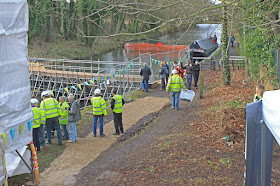Small Boat through Germany
by Roger Pilkington
December 2012
And so the last post of 2012, and what better subject than to return to the ongoing travels of the good ship Commodore.
Small Boat through Germany - Roger Pilkington
If you recall we left the Pilkington clan wintering their boat on the Rhine, the Commodore sheltering from the ice in 1962 and awaiting her further watery adventures along the German waterways. I knew that this episode would be particularly absorbing and I could tell that my anticipation was shared by Capt Pilkington all those years ago.
No sooner had the Commodore fired up her engine and taken on board a pilot than she was off down the mighty Rhine and into Binger Loch, or Binger Hole. This was and remains one of the Rhine's great bottlenecks, a spot where the Rhine narrows and shoals causing the water to pour through at 8 to 10 knots. At this speed it is beyond the scope of many freight craft who had to enlist the help of a fleet of tugs who patrolled to and fro, dragging the barges up the 2ft step with foam mounded at their bows and the water churned into a seething froth from the stern. The section was so dangerous that there were approx 900 "incidents" each year.
At the time of Commodore's passage the downward traffic passed down a water shute which ran at an estimated 10 knots. Taken as a whole the helter skelter run down the Rhine took just a day but such was Pilkingtons enthusiasm the account consumed all of 50 pages out of a 200 page book.
With the Dutch border approaching they turned into the heavily industrialised canals of Western Germany, taking them round from the grime of Dusseldorf and the Rhur for Munster, Osnabruck and the Henrichenburg boat lift at Minden, gateway to the River Weser.
The Weser consumed the bulk of the rest of the book. A lockless but fast flowing river which crawls south to north for several hundred kilometers. This is an ancient waterway and its history offers Pilkington rich pickings into its past and working practices.
A few key take outs about this waterway.
Due to its steady gradient it has been used by log rafts for many years, carrying timber from the Black Forest to markets far afield.
It is naturally shallow, only maybe 2 ft deep and maintaining water traffic in the dry season involved a tidal wave being created from the Eder Dam, a pile of water which downstream craft rode for days on end.
We are introduced to the concept of cold pressure travel, something I had never come across before. Such was the gradient on the river that an unpowered barge would slide forward at 2 knots, plus the current, which was enough to give them control and able to work their own way downstream.
Stopping the timber rafts was an art in itself. This involved a wooden anchor which was embedded in an adjacent meadow and ploughed huge furrows which remained visible for decades.
The flow made the upward journey very slow, even at full throttle, but gave ample opportunity to explore the surrounding towns and industries before turning tail at the end of the season and returning the boat to the Dutch base it started out from two years previously. Even this mega trip only scraped the surface of what is possible in Northern Europe and the book wistfully concludes with a list of other potential destinations - so many kilometers and so little time.








































